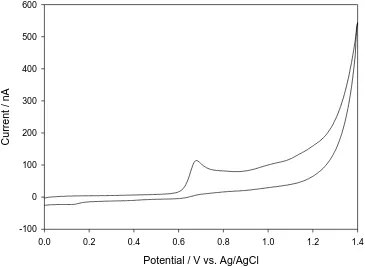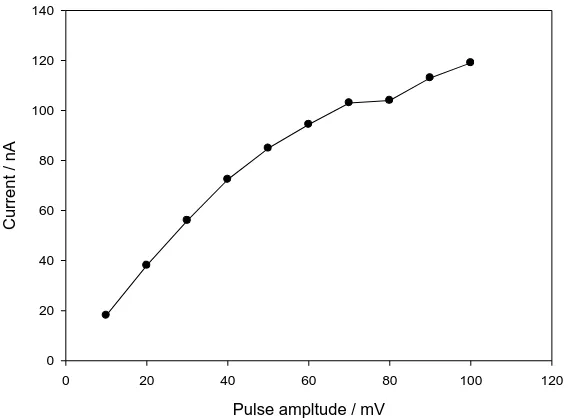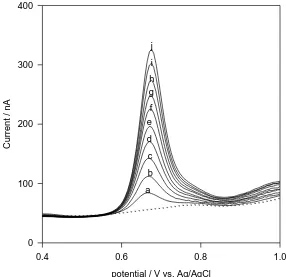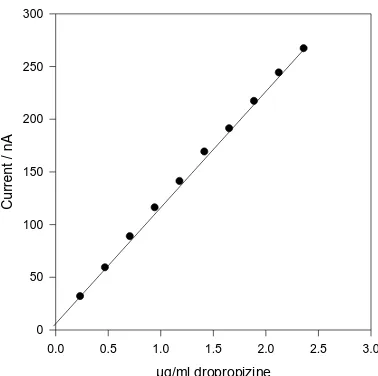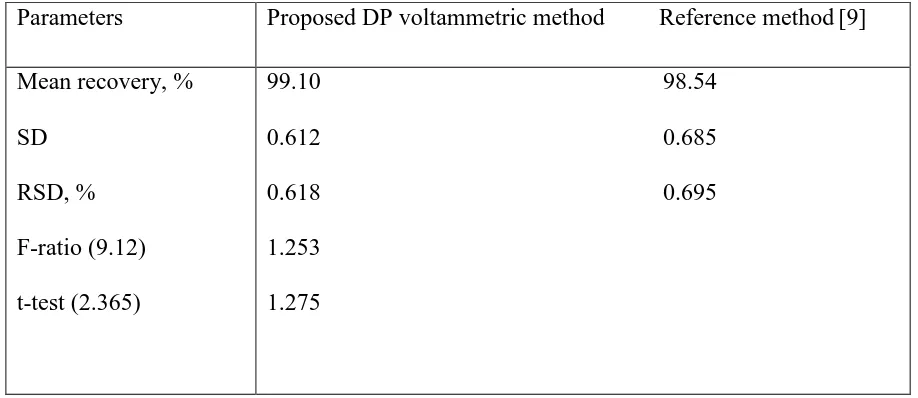Int. J. Electrochem. Sci., 10 (2015) 3250 - 3259
International Journal of
ELECTROCHEMICAL
SCIENCE
www.electrochemsci.org
Voltammetric Determination of the Cough Suppressant Drug
Dropropizine in its Pharmaceutical Formulations and Human
Urine
Sayed. I. M. Zayed1,2,*, and Hassan. A. M. Arida3,4
1
Chemistry Department, Faculty of Science, Taif University, 888-Taif, KSA
2
Faculty of Industrial Education, Beni Suef University, Beni Suef, Egypt
3
Faculty of Pharmacy, Taif University, 888-Taif, KSA
4
Hot laboratories Center, Atomic Energy authority, Cairo, Egypt.
*
E-mail: simzayed2011@hotmail.com
Received: 14 January 2015 / Accepted: 11 February 2015 / Published: 24 February 2015
The electrochemical behavior of dropropizine at carbon paste electrodes was investigated in 0.04 M Britton-Robinson buffer pH 6.25 using cyclic and differential pulse voltammetric methods. Cyclic voltammetric studies indicated that the oxidation of dropropizine at the electrode surface was irreversible, and mainly controlled by diffusion. Based on this a sensitive and simple differential pulse voltammetric procedure has been developed for determination of the drug over the concentration range 0.24 -2.36 µg/ml, with detection and quantification limits of 0.046 and 0.152 µg/ml, respectively. The developed method was successfully applied to the determination of dropropizine in lozenges tablets, and spiked human urine.
Keywords: Dropropizine, Carbon paste electrodes, Differential pulse anodic voltammetry Pharmaceutical dosage form, Human urine
1. INTRODUCTION
paste electrodes are widely applicable in electrochemical studies due to their low background current compared to the solid graphite or noble metals electrodes, low cost, easy preparation, and simple renewal of their surface. The present work aimed to study of the voltammetric behavior and assay of dropropizine at carbon paste electrode using cyclic and differential pulse voltammetry.
OH
OH N
N
Scheme 1. Structural formula of dropropizine
2. EXPERIMENTAL
2.1. Reagents and Materials
All chemicals were of analytical grade. Double distilled water was used throughout all experiments. Pure grade dropropizine and the pharmaceutical preparation Tussapine Lozenges tablets (20 mg dropropizine/tablet) were obtained from Eva pharma. Co., Cairo, Egypt., graphite powder (1-2 micron) from Aldrich, and paraffin oil from Merck. As a supporting electrolyte, a series of 0.04 M Britton-Robinson (BR) buffer pH 2.0-11.5 (a mixture of each of acetic, orthophosphoric and boric acids), adjusted to the required pH with 0.2 M sodium hydroxide was prepared
2.2. Apparatus
All voltammetric measurements were performed using Metrohm 797 VA Computrace (Herisau, Switzerland) equipped with a Metrohm VA 694 stand. Three electrodes assembly cell consisted of carbon paste electrode (CPE) as working electrode, an Ag/AgCl in 3 mol/L KCl (Metrohm 6.0728.000) as a reference electrode and platinium wire (Metrohm 6.0343.000) as an auxiliary electrode. The pH measurement were carried out with Hanna pH 211 microprocessor pH meter.
2.3. Preparation of carbon paste electrodes
electrode was immersed in the supporting electrolyte placed in the cell and several sweeps were applied to obtain a low background current.
2.4. Procedure
After 10 ml 0.04 M Britton Robinson buffer solution pH 6.25 was introduced into the voltammetric cell, a known amount of the drug solution was added into the cell. The differential pulse technique was applied by scanning from 0 to 1.4 V with scan rate of 30 mVs-1, and pulse amplitude of 40 mV.
2.5. Assay of dropropizine in Tussapine Lozenges tablets (20 mg dropropizine /tablet)
Twenty tablets (each contains 20 mg dropropizine) were accurately weighed and powdered in a mortar. The required amount from the crushed tablet powder was dissoloved in about 30 ml of methanol, and the mixture was filtered in a 100-ml measuring flask. The residue was washed three times by methanol and the volume was completed to the mark by the same solvent. After 10 ml 0.04 M Britton Robinson buffer solution pH 6.25 was introduced into the voltammetric cell, and a known amount of the tablet solution was added into the cell; The procedure is repeated as described above. The amount of dropropizine is calculated using standard addition technique.
2.6. Determination of dropropizine in spiked human urine
0.0236 g of dropropizine was dissolved in methanol and transferred to a 100 ml measuring flask; 5 ml of urine of a healthy person was added and the mixture was completed to the mark by the same solvent to prepare 10-3 M dropropizine in spiked urine sample. A 10-ml volume of 0.04 M Britton Robinson buffer solution pH 6.25 was introduced into the voltammetric cell; different volumes of the above spiked urine sample were added. The procedure is repeated as described above. The amount of dropropizine is calculated using standard addition technique.
3. RESULTS AND DISCUSSION
3.1. Cyclic voltammetric studies
oxidation current and the square root of scan rate, indicates that the oxidation process is controlled by diffusion [15]. This is confirmed by plotting the logarithm of peak of oxidation current vs. the logarithm of the scan rate, which give a straight line relation with slope of 0.566, which is close to the theoretically expected 0.5 value for a diffusion-controlled process. Also the peak potential shifts to more +ve values on increasing the scan rate which confirm the irreversibility of the oxidation process.
Potential / V vs. Ag/AgCl
0.0 0.2 0.4 0.6 0.8 1.0 1.2 1.4
C
ur
re
nt
/
nA
[image:4.596.106.471.188.455.2]-100 0 100 200 300 400 500 600
Figure 1. Cyclic voltammogram for 5.96x10-6 M solution of dropropizine in 0.04 M Britton-Robinson buffer pH 6.25 and scan rate of 50 mV s-1 on carbon paste electrode.
3.2. DP voltammetric studies
pH
0 2 4 6 8 10
C
ur
re
nt
/
nA
0 20 40 60 80 100
Pot
en
tial /
V
v
s
.
Ag/
AgCl
0.5 0.6 0.7 0.8 0.9 1.0
a
b
Figure 2. Effect of pH on the DP anodic peak current (a), and peak potential (b) of 2x10-6 M dropropizine in 0.04 M BR buffer, pulse amplitude 50 mV, and scan rate 50 mVs-1
The optimum instrumental parameters were chosen from a study of the change of the peak current of 2x10-6 M dropropizine with the change of the pulse amplitude and scan rate. The current increased linearly with the increase in the pulse amplitude over the range 10 – 40 mV pulse amplitude, then remains nearly constant (Figure 3). The current also increased linearly with increase of scan rate over the range 10 – 30 mVs-1, then remains nearly constant. Therefore 40 mV pulse amplitude, and 30 mVs-1 scan rate, were used for further measurements to obtain maximum sensitivity.
Pulse ampltude / mV
0 20 40 60 80 100 120
Current
/
nA
0 20 40 60 80 100 120 140
[image:5.596.132.468.91.316.2] [image:5.596.152.436.507.716.2]
3.3. Calibration graphs, limit of detection and limit of quantification
The dependence of the anodic differential pulse peak current on dropropizine concentration under the optimum conditions, show a linear relationship from 0.24 – 2.36 µg/ml dropropizine (Figure 4a and 4b). The linear regression equation was I (nA) = 110.46 + 8.87 C (µg/ml), with correlation coefficient of 0.9996. Limt of detection (LOD) and limit of quantification (LOQ) were calculated using the relation (k(SDa)/b) [16], where k = 3 for LOD, and 10 for LOQ, SDa is the standard deviation
of the intercept and b is the slope of the calibration curve, were found to be 0.046 and 0.152 µg/ml for LOD and LOQ, respectively. The analytical parameters for the calibration graphs are summarized in Table 1.
3.4. Reproducibility and robustness
The intra-day and inter-day (day-to-day) precision expressed as relative standard deviation were, 1.30 and 2.80 % (n = 6) for 2 x 10-6 M dropropizine.
The robustness [16] was also examined by evaluating the effect of small changes in the pH of buffer solution (6.15 – 6.45), and pulse amplitude (38 – 42). None of these changes significantly affect the recovery of the drug (Table 2); this provides an indication of the method reliability, and the developed method, could be considered robust.
potential / V vs. Ag/AgCl
0.4 0.6 0.8 1.0
Current /
nA
0 100 200 300 400
a b c d e f g h i j
[image:6.596.154.440.411.688.2]
µg/ml dropropizine
0.0 0.5 1.0 1.5 2.0 2.5 3.0
Current /
nA
[image:7.596.201.390.75.263.2]0 50 100 150 200 250 300
Figure 4b. Regression line for differential pulse voltammetric determination of dropropizine in 0.04 M Britton-Robinson buffer pH 6.25, pulse amplitude of 40 mV, and scan rate of 30 mVs-1
[image:7.596.99.493.366.479.2]
Table 1. The analytical parameters of the calibration graph for the determination of dropropizine using the differential pulse anodic voltammetric method
Parameter
0.24 – 2.36 110.46 8.87 0.9996 0.046 0.152 Linear range / µgml-1
Slope Intercept
Correlation coefficient ( r ) LOD / µg ml-1
LOQ / µg ml-1
Table 2. Robustness results of the proposed method
Variable Recovery, % SD
pH = 6.15 6.25 6.45
Pluse amplitude = 38 40 42
98.30 2.701 98.46 0.650 97.99 0.838
101.13 1.214 98.46 0.650 99.63 2.258
[image:7.596.129.466.532.731.2]
3.5. Interference
In order to prove the selectivity of the proposed method, interference from excipients usually present in pharmaceutical formulations was tested. The results indicate that no interference (< 2.01% change in the oxidation current), was observed in the presence of 100 fold excess of lactose, glucose, talc, starch maize, or magnesium stearate. According with these results it can be concluded that the proposed voltammetric method is sufficiently selective in quantification of the drug, and no previous separations or extractions were needed.
3.6. Analytical applications
3.6.1. Determination of dropropizine in Tussapine Lozenges
The proposed voltammetric method was applied to the determination of dropropizine in Tussapine Lozenges (20 mg dropropizine /tablet). The percentage mean recovery based on the average of four replicate determinations and the relative standard deviation values are summarized in Table 3. The data indicate that there is no interference from the excipients used in the formulations of the tablets. The results of the proposed votammetric method was statistically compared with those obtained by UV spetrophotometric (manufacturer procedure supplied by Eva pharma. Co.) [9]. Statistical comparison of the results was performed with regard to accuracy and precision using Student's t-test and the F-ratio at 95% confidence level [17]. The results (Table 3) indicate that the calculated t- and F-values did not exceed the theoretical values, there is no significant difference in accuracy or precision between the proposed and the reference method.
Table 3. Statistical comparison between the results of Tussapine Lozenges using the proposed DP voltammetric method and the reference manufacture method
Parameters Proposed DP voltammetric method Reference method[9]
Mean recovery, % SD
RSD, % F-ratio (9.12) t-test (2.365)
99.10 98.54 0.612 0.685 0.618 0.695 1.253
[image:8.596.69.528.522.721.2]
3.6.2. Determination of dropropizine in spiked human urine
[image:9.596.91.484.323.421.2]Studies described on the metabolism and toxicologic analysis of dropropizine in human urine using gas chromatography-mass spectrometry (GC-MS) [7], showed that dropropizine was metabolized in humans, the results showed the unambiguous detection of dropropizine and its metabolize in human urine up to 32 hours after intake of a single dose. The target analytes were found to be the parent compound dropropizine through the earlier phase of excretion. The high selectivity of the proposed voltammetric method allowed the determination of dropropizine in spiked human urine samples at two different levels of concentrations: 2.00x10-6 and 2.99x10-6 M dropropizine. Five determinations were carried at each concentration level (Table 4). The two mean recoveries for the two concentration levels were 99.00 and 99.33% with relative standard deviations of 1.19% and 0.62%, respectively.
Table 4. Determination of dropropizine in spiked urine samples using the proposed method Taken (M) Found (M) Recovery, % RSD
2.00x10-6 2.99x10-6
1.98x10-6 99.00 1.19 2.97x10-6 99.33 0.62 Average of five determinations
4. CONCLUSIONS
In this work, the anodic voltammetric behavior of dropropizine at carbon paste electrode was investigated by cyclic and differential pulse voltammetry, and on the basis of these voltammetric studies an analytical procedure for the determination of the drug in its pharmaceutical formulation and human urine was developed. The developed voltammetric method has advantages such as simple, sensitive, rapid, low cost, and ease of preparation, and easy renewable of carbon paste electrode. The proposed method is less expensive than alternative techniques like HPLC, and hence can be applied to the routine determination of the drug in quality control laboratories.
ACKNOWLEDGEMENTS
This work was financially supported by Taif University, KSA, project No: 1-435-3261
References
2. F. Tagliaro, M. Moffa, Z. De Battisti, F. P. Smith and M. Gentile, J.Chromatogr. B Biomed. Appl., 685 (1996) 165.
3. B. I. Jin-lian and L. I. Xiang-bin, China J. Modern Medicine, 15 (2005) 1888. 4. L. Yan, T. Li, R. Zhang, X. Xu and P. Zheng, Arch Pharm. Res., 29(2006) 514.
5. M. Jin, Q. Ling, L. Xiao-Ye, Q. Xiamg-Yamg, Z. Ai-Li, L. Dan and S.Xiao-Li, J. Fourth Mil Med Univ., 30 (2009) 377.
6. P. Zaratin, L. De Angelis and F. Cattabeni, Arzneimittel-Forschung, 38 (1988)1156. 7. R. F. Staack, D. S. Theobald and H. H. Maurer, Ther Drug Monit., 26 (2004) 441.
8. S. S. Abbas, H. E. Zaazaa, M. Abdelkawy and M. M. Abdlrahman, Egypt.J. Pharm. Sci., 50 (2009) 25.
9. O. M. Abdallah, Inter. J. Anal. Chem., 2010, (doi: 10.1155/2010/704564).
10.F. M. Abdel-Gawad, C. S. Mostafa, S. M. Abdel Hamid, M. M. AbdelMoaty and N. A. Abbas, Egypt. J. Chem.,, 53 (2010) 631.
11.F. M. Abdel-Gawad, C. S. Mostafa, S. M. Abdel Hamid, and N. A. Abbas, Egypt.J. Chem., 53 (2010) 101.
12.H. M. Elwy, S. M. Abdel-Hamid, F. M. Abdel-Gawad, in Proceedings of the Fifth International Conference on Advances in Chemistry and Applied Chemistry, 2014, Organized by Chemical Industries Research Division, National Research Centre, Dokki, Cairo, Egypt.
13.F. Agin, N. Karadas, B. Uslu and S. A. Ozkan, Curr. Pharm. Anal., 9 (2013) 299
14.A. Elyacoubi, S. I. M. Zayed, B. Blankert, and J.-M. Kauffmann, Electroanalysis, 18 (2006) 345. 15.P. Monk, "Fundamentals of Electroanalytical Chemistry," Wiley (2001) 162
16.M. Swartz and I. S. Krull, "Analytical Method Development and Validation" Marcel Dekker, Inc., (1997) 61.
17.J. C. Miller and J. N. Miller, "Statistics for Analtical Chemistry", 3rd ed., Ellis Horwood Chichester (1993) 53.
